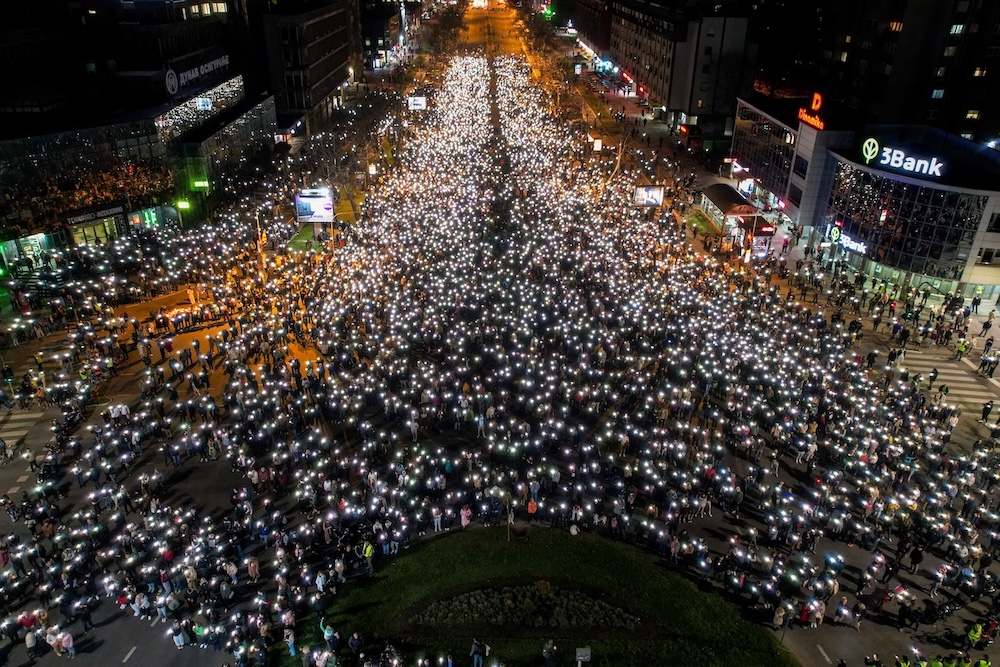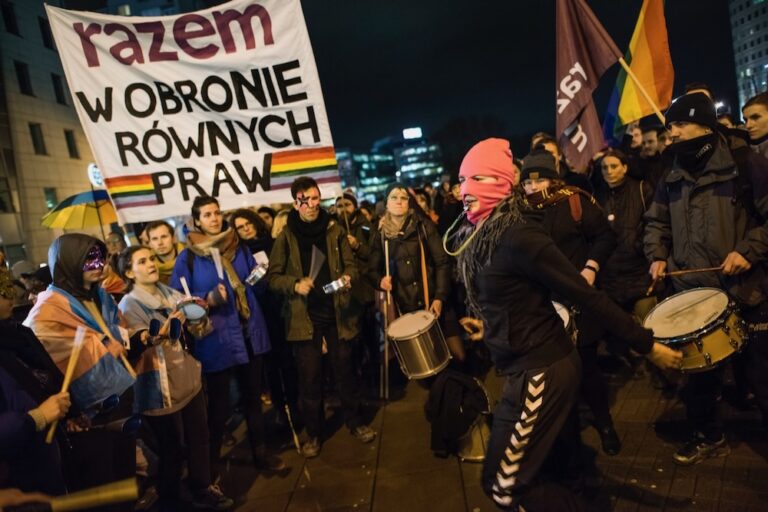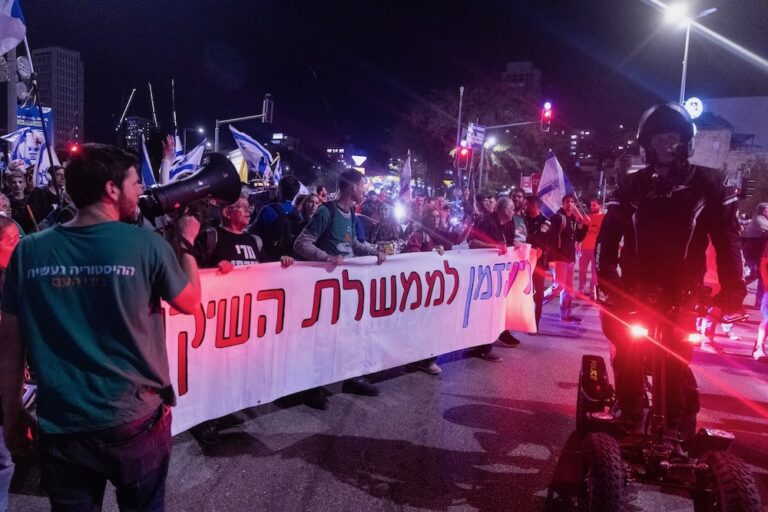Frequent references to 'colour revolution', 'traditional values', the 'evil' West, and 'Maidan' are lifted out of the Russian playbook on undermining peaceful demonstrations.
This statement was originally published on globalvoices.org on 22 May 2025.
Russia amplifies framing of protests as coup attempts and part of Western interference against sovereignty of Serbia, Slovakia and Georgia
This collaborative article by the teams of Istinomer (Serbia), Demagog (Slovakia), and FactCheck (Georgia) originally appeared at Istinomer (Truth-O-Meter), a fact-checking initiative of the Center for Research, Transparency and Accountability (CRTA). An edited and updated version is published below as part of a content-sharing agreement with Global Voices.
Protests have erupted across Georgia, Slovakia, and Serbia, each fueled by distinct political crises but met with strikingly similar manipulative narratives from their governments. Despite the differences in local contexts, the ruling parties in all three countries deploy parallel rhetorical tactics to discredit protesters, delegitimize criticism, and consolidate their power.
In the political scene of these countries we are seeing governments that are openly distancing themselves from the EU, leaning toward Russia, or doing so less openly while employing Russian propaganda tactics. Mass protests by dissatisfied citizens on one side are pit against politicians in power who seem to be using the same playbook (and narratives from Russia’s playbook). Phrases about a color revolution, traditional values, the “evil” West, and Maidan (referring to Ukrainian Euromaidan uprising of 2013), are being repeated.
Foreign interference and the ‘Color Revolution’ playbook
In all three countries, governments frame protests as foreign-instigated attempts at a “color revolution.” The tactic is not new, but has resurfaced with renewed intensity.
In Georgia, the ruling Georgian Dream party accuses the West and international organizations such as USAID and NED of inciting a “Maidan-style” coup through local agents — NGOs and activists. For example, Prime Minister Irakli Kobakhidze has accused domestic critics of being “agents of the Global War Party” who tried to overthrow the government and drag Georgia into war with Russia four times since 2022.
In Slovakia, Prime Minister Robert Fico claims the protests are backed by foreign actors, including the Ukrainian intelligence service and the Georgian Legion, linking demonstrations to the Maidan uprising in Ukraine.
In Serbia, President Aleksandar Vučić revives 1990s rhetoric, portraying protesters as Western mercenaries aiming for a foreign-backed coup. He dismisses student demonstrations as a covert attempt at destabilization, also framing the protests as “color revolution.”
Delegitimizing protesters and denying agency
Another common tactic is the portrayal of protesters as puppets of foreign agendas, stripping them of personal agency and genuine grievances.
In Georgia, demonstrators against the Russian-style foreign agents law are painted as radicals, “liberal-fascists,” “LGBTQ+ activists” and anti-church agitators, accused of spreading “Western propaganda.” Protesters are also called “homeland-less” (meaning that their loyalties lie in other countries, rather than to Georgia) and “foreign agents.”
In Slovakia, the government propagates the false claim that one-third of protesters are Ukrainian nationals bussed in by the opposition.
In Serbia, the government weaponizes nationalism, accusing students of being Croatian spies and framing protests as a plot to separate Vojvodina from Serbia.
Fear, conspiracy, and hybrid warfare
All three governments lean on fear-based messaging, framing protests as precursors to violence and chaos.
Georgian authorities, including the State Security Service, warn of a foreign intelligence-backed violent coup, which will be followed by a war with Russia. Pro-government channels amplify conspiracies tying protests to Western plots to open a second front against Russia in Georgia. Without producing any evidence, Georgian officials systematically accuse international organizations of foreign interference and violating Georgia’s sovereignty by funding local CSOs and watchdogs, as well as the protests.
Russia amplifies Georgian ruling party’s framing of protests as coup attempts, which will be followed by a war with Russia. Head of the Russian Foreign Intelligence Service, Sergey Naryshkin stated that “Tbilisi is facing another attempted color revolution, or rather, a coup d’état” similar to “previous brazen attempts to destabilize Belarus and Kazakhstan that failed.”
In Slovakia, bomb threats and cyberattacks are linked to protesters without evidence, fueling the narrative that demonstrations are part of a larger destabilization effort.
Slovakian government is using a narrative of foreign interference and parallels with color revolutions, aiming to delegitimize the demonstrations and portray the opposition as part of a broader conspiracy against the state. Prime minister Fico blamed a shadowy “group of experts who had participated in protests in Georgia and Ukraine,” has been destabilizing the country. Fico and Interior Minister Šutaj Eštok also implied foreign interference from Ukraine, claiming significant portion (one third, sometimes even one half) of the protesters were Ukrainians, imported by buses by opposition parties (STVR).
Serbian officials and pro-government media spread conspiracy theories that the Novi Sad canopy collapse – a tragic accident – was an act of diversion aimed at destabilizing the country. They also claimed that protests are destroying the economy of Serbia.
Vladimir Đukanović, a MP from the ruing Serbian Progressive Party, blamed watchdog civil society organizations Trag and CRTA for “preparing chaos and a color revolution in Serbia,” while being as “financed by an organized criminal group, USAID, which used money from drug trafficking covering Mexican cartels.” After Serbian Parliament Speaker Ana Brnabić referred to the protests as a “well-coordinated action from abroad,” media outlets aired comparisons with protests against Russian President Vladimir Putin, suggesting that the opposition aimed to “overthrow the government using a Ukrainian-style approach” orchestrated by “the same centers of power.”
Aligning with global authoritarian trends
The narratives in all three countries mirror broader authoritarian trends. Terms like “deep state,” “foreign agents,” and “color revolutions” have become tools to smear opponents and justify crackdowns on civil society.
The overlap in narratives across Georgia, Slovakia, and Serbia is not coincidental but a shared authoritarian playbook that weaponizes disinformation and fear to suppress dissent. While each country faces its unique political challenges, the echoing rhetoric underscores a global trend of democratic backsliding.
What is really going on lately in these three countries?
In early November 2024, a canopy collapsed at the Novi Sad railway station, resulting in the deaths of 15 people. After that, protests against corruption have been ongoing across Serbia for over three months, led by students. In parallel, teachers, students, and graduates have continued protests and school blockades nationwide. By the end of January 2025, over 416 cities and villages have witnessed protest actions. Public opinion survey conducted by CRTA in February showed that approximately 80 percent of Serbians support the student demands, with a third of the population participating in protests.
International watchdog Freedom House warned that Serbia has experienced its sharpest decline in democracy and human rights in the past decade. Amnesty International recently uncovered Serbia’s extensive use of surveillance technologies like NSO Group’s Pegasus spyware and a newly disclosed domestic Android NoviSpy system to suppress civil society. President Vučić, continues to function as a “spin dictator,” (authoritarian ruler that allows some democratic expression while overwhelmingly suppressing dissent), while the media continue to focus on him as a central figure, shaping his cult of personality, while spreading anti-Western narratives.
After Slovak Prime Minister Robert Fico’s unannounced meeting with Russian President Vladimir Putin in Moscow in December 2024, a wave of public outrage erupted, leading to protests. The backlash intensified following remarks by the Deputy Speaker of Parliament, later endorsed by Fico himself, that Slovakia should not rule out the possibility of exiting the European Union. In response, protest organizers mobilized demonstrations to reaffirm Slovakia’s commitment to EU membership..
Protests are taking place in more than 50 cities across various regions of Slovakia. The largest protest, on February 7, 2025, saw more than 100,000 people take to the streets: 45,000 in Bratislava, 20,000 in Košice, 8,000 in Banská Bystrica, as well as many smaller cities that do not have a tradition of organizing protests.
The protests are organized every second Friday by the organization Mier Ukrajine (Peace to Ukraine). They initially began as a reaction to Prime Minister Fico’s visit to Moscow but later expanded to express broader societal dissatisfaction with the government’s actions. Protesters demand that the prime minister stop attempting to change Slovakia’s foreign policy orientation, questioning its membership in the EU and NATO, and seeking cooperation with Russia. They also call for an end to attacks on Ukraine and demand the prime minister’s resignation.
In June 2022, mass demonstrations erupted after Georgia failed to secure EU candidate status. In February 2023, the ruling party introduced a Russian-style “foreign agents” law, widely seen as incompatible with international human rights standards on freedom of expression and association and to the 78th article of Georgian Constitution, which obliges all constitutional bodies to take all measures within the scope of their competences to ensure the full integration of Georgia into the European Union and the North Atlantic Treaty Organization. Due to protests and international condemnation, the draft law was retracted. However, in April 2024, the ruling party re-introduced it after promising it would not do so. Despite months of protests throughout Georgia, condemnation from Western partners, violent crackdowns on demonstrators, and a presidential veto, the law was ultimately passed in June, 2024.
Protests reignited after the October 26 parliamentary elections, but it was the Georgian Dream’s statement on November 28 that ignited protests that have persisted since. The party declared that it would “not put the agenda of opening the accession negotiations with the EU before the end of 2028. Also, until the end of 2028, we reject any budget support grant from the EU” — effectively halting Georgia’s EU integration process.
People came out en masse in front of the parliament in Tbilisi and authorities responded by cracking down on protesters and journalists, arresting and beating them. Since the protests, the Georgian Dream has adopted several repressive laws increasing fines on protesters, making it easier to fire civil servants, expanding the scope of political appointments in civil service, expanding the scope for extrajudicial detention, and simplifying new recruitment into the police force.
Recently, the ruling party introduced further legislation aimed at censoring independent media and stifling civil society organizations. Despite the increasing authoritarianism, the protesters continue to demand snap elections and release of political prisoners.



